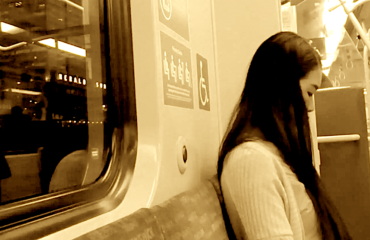Not long after midnight on April 21, 1908, Daniel Abraham searched frantically for his friend Joseph Davis among the dead and injured lying on a dimly lit platform of Spencer Street railway station.
Just hours earlier the Bendigo express, on its way to Melbourne, had smashed into the back of the Ballarat train, which was pulling out of Sunshine station.
Joseph was a passenger in one of the Ballarat train’s rear carriages, which were reduced to “matchsticks” by the impact, The Argus reported next day. The injured and dead had been brought to Melbourne for treatment or identification.
Daniel found Joseph alive, but in a bad way, and arranged for him to be taken to Dr Sterling’s private hospital in Carlton.
Who was Joseph, and what life did he lead before this catastrophic accident?

The story begins in the early 1850s when 300 Jewish families from London and the province of Posen, Prussia, made the journey to Melbourne seeking a better life. John and Adelaide Davis were among the settlers, hoping to start a family and prosper in the new land.
Their son, Joseph, was born soon after Victoria separated from NSW in 1851. He was to witness the birth of the Australian nation and see the first federal Parliament meet in the Royal Exhibition Building near his home in Lansdowne Street, East Melbourne.
Joseph was born in Melbourne in 1854 as fortune-seekers arrived for the gold rush. His father, John, traded as a clothier at 221 Elizabeth Street, Melbourne, receiving deliveries of “slops clothing” like other Jewish merchants from the nearby Yarra River docks, according to the Melbourne Hebrew Congregation’s records.
Joseph’s wife, Rosa, was born in Ballarat in 1860 and spent her early life in a city founded on the gold rush. The family lived at Ballarat East and her father was a furniture dealer.
Joseph and Rosa were married at the Ballarat synagogue in 1883, most likely through an arrangement between their families. Joseph is recorded as being a merchant, and Rosa, a teacher on their marriage certificate.
Joseph had started work in his father’s shop and in 1880 branched out with a partner, operating as Friedman and Davis, a merchandising company based at his father’s Elizabeth Street premises and later at Stanley Street.
Joseph and Rosa set up house in Melbourne, initially at the Davis home and business in Elizabeth Street. By 1885, Joseph and his father had become pawnbrokers as well as clothiers.
Rosa gave birth to their first child, George, in 1884, while daughter, Violet, followed in 1888 and another son, Frank, in 1893.
By the late 1890s, Joseph’s fortunes had reached their peak. The family lived in a handsome townhouse at 21 Lansdowne Street, East Melbourne, and the humble pawnbroker and clothier had become an exclusive foreign stamp dealer and importer at Shop 10, The Block Arcade, in Elizabeth Street, Melbourne.
The arcade was part of the most fashionable and richly decorated shopping precinct in Melbourne. Men promenaded in one direction around the streets and women in the opposite direction, particularly before attending Australian Rules football matches, according to the arcade’s website.
By 1905, he had returned to pawn broking, this time at 344 Brunswick Street, Fitzroy, which was also the new family home. He gave loans for sums as low as 6 pence on items of underwear and sometimes up to £2 for gold jewellery. The probate papers of Joseph’s will list all of the items in his shop, with brooches clearly being the most popular item to pawn.
Joseph’s shop was in the heart of Melbourne’s Jewish community that had taken root in Carlton and Fitzroy in the 1860s, and continued to the mid-20th century. A rich Yiddish culture existed alongside Joseph’s Anglo-Jewish tradition, according to the Fitzroy Historical Society.
Joseph and his family were members of the Melbourne Hebrew Congregation in Bourke Street, characterised by dutiful, but not rigid observance of Judaism. These Jews sought to integrate with the dominant English culture of Melbourne while inconspicuously practising their faith.
The continental European Jews who had migrated to Melbourne rejected this approach and founded the East Melbourne Jewish congregation, which emphasised strict religious observance and maintained ethnic traditions and languages, according to the local history, Fitzroy – Melbourne’s First Suburb.
Liz James is a volunteer at the Australian Jewish Genealogical Society. She says that the story of the Davis family was typical of English Jews.
“These families escaped the poverty of Spitalfields in London in search of a better life. They just wanted to be accepted by their new society and make a contribution to building Melbourne.”
“They saw themselves as ‘English’ and while maintaining their Jewish faith, they did not want to be solely defined by it.”
James believes that Joseph and Rosa were similar to many Jews in Melbourne today. “Blending in, being part of society, not standing out and doing enough to preserve the faith and traditions – that’s what many Jewish families aspire to today,’’ she says.
“Marrying out of the faith is still a significant issue. I think Joseph and Rosa would have been pressured to marry another Jew, and while it is less so today, many are worried about how we will keep the faith alive and vibrant.”
Joseph had business dealings in Ballarat and during Easter 1908 visited the city, unaccompanied by family. He returned on the Ballarat mail train on the night of Easter Monday April 20, 1908 and was in one of the rear carriages struck by the Bendigo train.
Despite the efforts of his friend, Daniel Abraham and Dr Sterling, Joseph died the following day from “shock supervening upon compound fracture of the leg and internal injuries” as reported by The Age on April 22. He was buried two days later in the Jewish section of the Melbourne General Cemetery.
Members of the Victorian Philatelic Society attended the funeral, The Argus reported.
Joseph was 54 years old.
The Sunshine railway disaster is still the worst in Victoria’s history. The final death toll was 44, with more than 100 seriously injured.
The probate documents of Joseph’s will provide evidence of his success as a businessman. Stock in his pawnshop and debts payable to him were worth £105. He had £101 in his bank account and life insurance of £570. The estate amounted to £809 with Rosa the main beneficiary. Joseph dutifully left £5 to the Melbourne Hebrew Congregation. The basic weekly wage at that time was £2-2-0.
However, the damages paid by the Victorian Railway Commissioners, who had accepted liability for the Sunshine disaster, provided far more generous compensation to Joseph’s family – £2000, about $660,000 in current value.
Rosa moved to Woodside Crescent, Toorak, and died 20 years later. She is buried in the same grave as Joseph, a procedure requiring the special approval of a rabbi.
Joseph’s oldest son, George, moved to Sydney before his father’s death, followed some years later by younger brother Frank. Violet remained in Melbourne and died in 1969.
Frank Davis’ daughter, Judy Redelman continues to live in Sydney, piecing together the family history. Along with the Liz James at the Jewish genealogical centre, she ensures that Joseph, Rosa and their family are not forgotten.
A weathered granite monument in the Melbourne General Cemetery, with its bold English and Hebrew inscriptions, offers scant testament to the lives of Joseph and Rosa Davis.
It tells of ‘‘Joseph, the beloved husband and affectionate father, died in 1908’’, and ‘‘Rosa, the darling mother of George, Violet and Frank, died in 1928’’.
One Hebrew inscription states “A life cut short”, but does not disclose how.




